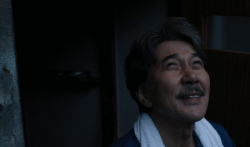“In the Blood,” staged by the Black Theater Ensemble and written by Susan-Lori Parks, is a dark tale of a woman whose poverty and sexual prowess have given her five bastard children and a life of perpetual social exclusion. The story is loosely based on Hawthorne’s “The Scarlet Letter”—although the only vestiges of that archetypal classic are Hester La Negrita (the heroine) and an abundance of A’s (the only letter that Hester can read or write).


Hester’s family inhabits an alley shanty made of tin and cardboard, constantly lit by a trash can fire and nestled between graffiti-covered concrete walls. As the play begins, Hester (Nicole Lewis, COL ‘08) has set the local community talking by giving birth to another child, Baby. Hester possesses a passion for thematic simplification, naming all of her children after their fathers’ natures: her eldest and favorite son is Jabber, her second son is Trouble and her two girls are Beauty and Bully. Between scenes of hopeful pining for her children’s fathers to return, in which she proclaims that she is just waiting for her “leg up” in the world, Doctor (the town doctor) visits Hester and urges her to get a hysterectomy and Welfare (the town welfare director) pretends to be interested in her lack of employment.
Hester is set apart from all the others waiting for their “leg up” in the world by her sexual powers. As Hester’s prostitute friend Amiga (Kelsey Spitz, SFS ‘10) sneeringly emphasizes in a chanting refrain, Hester is good at one thing: sex. Hester has backed Doctor into an alley corner (an experience he lamely dubs phenomenal), been paid to have threesomes with Welfare and her husband and had sex with Amiga before an audience of men. The scenes of Hester and her children are interrupted by stories of her sexual past told by her partners, who briefly pop out of their normal busy lives to relive their moments in and with Hester’s body.
The sexual monologues serve as a personal test for each actor, highlighting the weakness and strengths of the show’s cast. As Amiga, Spitz hungrily rakes the audience during her lesbian monologue, looking for a pair of shocked eyes to focus on; Jasmine Taylor (COL, ‘10), as the snobby, nasty welfare woman, stares haughtily into the crowd, repeating the same hand gesture over and over. Paul Notice II (SFS ’09), as Reverend, slips with great skill between his sexual character and street-preaching alter-ego.
Amidst the sordid sex tales, it is easy to confuse a good story with good storytelling. Carefully staged accents slip, monologues are delivered incomprehensibly fast and Hester’s lovers lack depth, despite their deep sexual secrets. Each lover also plays the child that was born from his or her encounter with Hester. The children’s scenes are lively, humorous and more convincing on the whole than some of the strained sexual dialogues, perhaps because the cast engages mostly in improv while performing. Lewis, as Hester, is remarkable: her raspy voice effortlessly switches between bitter, cursing rages and tender, motherly endearments. Willie Bodrick II (COL’10), as the simple-minded Jabber and his pompous father Chilli, gives a good show as the groomed playboy; though wounded by his former lover’s philandering, he nevertheless attempts to give Hester that “leg up” she is waiting for.
Waiting to be lifted up, however, nearly guarantees that someone will let you fall, and Hester falls hard. The play ends with a tragic, confusing twist that brings an end to Hester’s desperate attempt to love in spite of sex, and have sex in spite of a lack of love. As the lights go out, Hester brings some tears to the eyes. Because the play pushes themes of corruption and selfishness, the audience is compelled to blame her rather than her surroundings. The play also attempts to address several more themes including adultery, love and the nature of sin, but fails to bring a satisfactory conclusion to any. But as a well-acted, unusual piece, “In the Blood” is worth the thematic confusion, even if the tangle does not deliver a resolution for either Hester or the audience.
“In the Blood” is showing February 13-15 at 8 p.m.; February 16 at 2 p.m. and 8 p.m.; February 17 at 2 p.m. at the Walsh Black Box.




